
 |
|||||
|
|
|||||
|
|
|
|||||
|
|
CLAYGATE PEARMAIN Discovered by John Braddick growing in a hedge near his home at Claygate, near Thames Ditton, Surrey. In 1822 he sent specimens to the London Horticultural Society, who agreed that "it is unquestionably a first rate dessert apple". The juicy, crisp fruits have a tangy flavour initially, similar to Cox’s Orange Pippin and become sweet, rich and nutty when stored. The tree is moderately vigorous, upright, spreading and partially tip bearing, but not short of spurs. Good crops. Pretty blossom and buds T*.Pollination Group 4 |
|
|
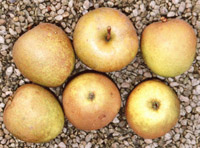 |
COCKLE PIPPIN Once also called Nutmeg Cockle, Nutmeg Pippin and White Cockle, though the name Nutmeg Pippin properly belongs to another apple. An eating apple which became popular in the 19th century for its sweet, aromatic, firm textured fruit. Raised by Mr Cockle of Godstone in Surrey (though Bunyard says he was from Sussex) around the start of the 19th century, and widely grown in Surrey and Sussex in the 20th century. A late and small truncate conic apple with yellow/green skin and cinnamon russet. The dense flesh is very richly flavoured, but the apples must be left on the tree until fully ripe, or they can be quite sharp. Upright trees with heavy crops. Pollination Group 4 |
||
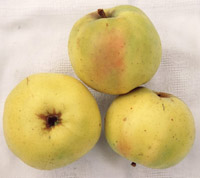 |
COCK-PIT Also known as Summer Cockpit and Yorkshire Cockpit. A highly regarded Yorkshire apple, also grown in other northern counties. The first record was in 1816, in the nursery catalogue of Backhouse, of York, where it was spelt Cock-Pit. In 1826, it was in the first collection catalogue of the London Horticultural Society. It is a medium sized, late season cooker, ripe in late September with us and in October in the North. It will keep until December but from November it is a fine sweet, crisp and juicy apple to eat raw. The shape is angular and ovate with flesh of yellowish white, very juicy and with good acidity. The yellowish skin is sometimes flushed orange-red. When cooked it is pleasantly sweet and rich, keeping some shape, but it would mash. A good bearer with pretty pale blossom. T*. Pollination Group 4 |
|||
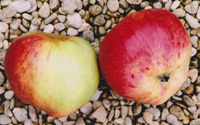 |
CODDENHAM
RED Fruit and scions were brought to us by Jane Peecock, of Coddenham,
Suffolk in 2007 and the name was given by her, the original one now lost.
This old and individual apple tree grows in the garden of a 15th century
coach house, in the rural village of Coddenham, north of Ipswich. A large
cooking apple with rosy streaked flesh, that, when cooked, partly keeps
its shape and takes on a pink colour. The flavour is rich and is highly
recommended by Jane for pies and crumbles. Ripe in October. Pollination
Group 5 |
|||
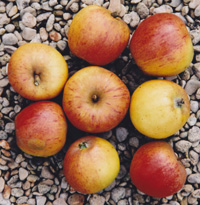 |
COE’S
GOLDEN DROP A small, richly flavoured dessert apple, which was
seemingly raised by Jervaise (or Gervase) Coe, of Bury St. Edmunds, Suffolk,
around 1790, though Hogg (1884) suggests it might have been an older variety
from the Essex orchards, merely propagated by Coe as being his own. The
first formal record was in 1842, when it was in the collection of the
London Horticultural Society. The fruit is small and conical, with yellow
skin, blushed with crimson in the sun and with a few patches of thin russet.
The flesh is crisp and very juicy. ‘A delicious little dessert apple
of the first quality', according to Hogg, in season from November to May.
Scott, in ‘The Orchardist’ of 1872, described it as being
of top quality, golden yellow when ripe, with crimson dots and tracings
of delicate russet. He added that the stalk is 1 inch long, inserted in
a small russeted basin, the russet spreading over the base. The eye is
small and open, set nearly level and surrounded with a few plaits. The
flesh is greenish yellow, firm and crisp, with juice abundant, rich, sugary
and vinous. The tree is a dwarf upright grower and bears well. The apple
was illustrated in the Herefordshire Pomona of 1876-85. Taylor (1946)
said that it was faintly blushed brown. Once universally popular, this
apple was even taken to Australia. It was included in the Royal Society
of Van Dieman’s Land 1855 list of fruits, growing in the Society’s
gardens. Van Dieman’s Land was the early name for Tasmania, the
name changing in 1856. Many old English apples and other fruits were taken
to Australia by early settlers and the spelling of the apples and pears
in this list suggests they were in Australia, under early spellings, at
the start of the 19th century. For example, the apple Beachamwell was
spelt Beauchampwell, the earlier name that had been replaced by the 1830s.
In modern times there has been some uncertainty about the authenticity
of this apple in some collections. It was withdrawn from the National
Collection at the start of the 21st century, perhaps under the assumption
that it was falsely named. It does not appear to have been in the National
Fruit Trials at the time of the National Apple Register but was in the
collection in 1960, when material was donated to the US Department of
Agriculture collection at Geneva, New York. They still have it, but their
example shows a more rounded and flattened form than the conical apple
illustrated in the Herefordshire Pomona and described in the 19th century.
It is still held at Wisley, where it is more conical and closer in appearance
to old descriptions. Our apple came from America and matches old descriptions,
though our soil produces more red streaks and less russet. A very good
apple. Pollination Group 4 |
|||
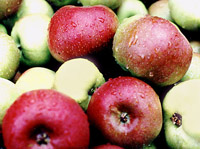 |
COEUR
DE BOEUF An old French culinary apple, possibly dating back to
the 1200s, and grown in Britain before 1826. The fruit is very handsome,
large and flushed with rich mahogany red and streaked with brighter red.
The flesh is also flushed with red in places - hence the French name ‘heart
of beef’. Though rather large, the apples can be eaten raw and are
crisp, juicy, fruity and sweet. They will also cook to a full-flavoured
sweet purée. Ripe in October, the apples will keep until May. Free
spur bearing. T*. Pollination Group 4 |
|||
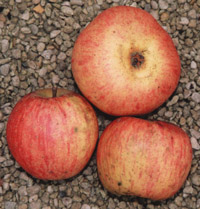 |
COKER
SEEDLING First noted at the Apple and Pear conference of 1934,
but a much older variety, from Somerset, named after the village of East
or West Coker. It was described by Taylor in 1946 as a large cooking apple,
similar to Warner's King, but sometimes with a number of wide, scarlet
stripes and a flush of scarlet. He adds that the base is usually flat
and that it is ripe in September. It became unknown, outside of West Coker,
until Angus and Marilyn McPhee had confirmation from a 90 year old local
that the old tree in their garden, now leaning at 45 degrees, was always
known to him as Coker Seedling. Angus McPhee kindly sent us scions in
2007. It is a top quality early season cooker, fully matching the early
descriptions. Medium to large, ripe in September and only lasting to the
end of October. The rich, fragrant cream flesh is sweetish enough to eat
in October but is best as a rich and tangy cooker which completely keeps
its shape. Pollination Group 4 |
|||
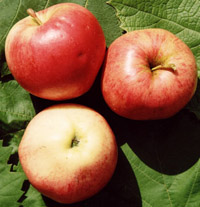 |
COLE
First recorded in the first catalogue of the London Horticultural Society
of 1826 and included in later catalogues. It was described simultaneously
by Lindley and Ronalds in 1831, with descriptions broadly in agreement.
Ronalds said it was ‘a new sort’, but Lindley made no such
observation and it had already acquired a synonym of Scarlet Perfume,
noted by Lindley, so it might be older. Scott (1872) and Hogg (1884) also
described it well, but there are slight differences between all descriptions.
It appeared lost in this country for a century but we repatriated it in
2002 from the U.S. Plant Genetic Resources Unit at Cornell University,
Geneva, New York, who, in turn, had received it from Victoria, Australia
in 1938. The characteristics are fully in accord with the old descriptions,
given the variability of the latter. Lindley described it as “Fruit
above the middle size, about three inches and a quarter in diameter, and
two inches and a quarter deep, angular in a slight degree, with a wide
eye, mostly closed by the segments of the calyx. Skin deeply stained,
and streaked with crimson, slightly russeted, with a small portion of
it showing through. Stalk woolly, sometimes inserted beneath a deep lip
protruding into the cavity of the base. Flesh white, firm, juicy, sweet
mixed with acid, little perfumed, very rich and agreeable. A very excellent
autumn dessert apple, in perfection about the end of August, and will
keep sound till Christmas. It is a healthy, hardy variety, but better
adapted for dwarfs than for standards’. Others put the season a
little later, but we find its ripening time varies significantly with
the year’s weather, as to when it comes to perfection in ripeness.
It is usually ripe in September here and will certainly last until Christmas.
The apple has the valuable characteristic that the flesh remains white
when cut, even overnight. A very good, rich and refreshing apple. Pollination
Group 4 |
|||
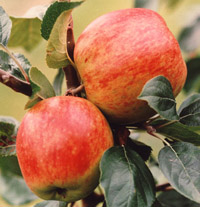 |
COLONEL
VAUGHAN’S In past catalogues we have fallen into the trap
of blindly accepting the assumption of Hogg (1884) and others that Colonel
Vaughan was the same as Kentish Pippin. They have added the history of
the ancient Kentish Pippin to Colonel Vaughan, though the former is a
large, sweet cooking apple and the latter a small to medium sized dessert
apple. We apologise for leading our readers astray. Colonel Vaughan is
not Kentish Pippin, though we know many in modern times suggest it is.
The true Kentish Pippin remains lost, though old anonymous trees of it
will still exist somewhere. Though we can trace where the errors began,
we will not overburden this description with a long narrative on that.
The name Colonel Vaughan’s first appears in the 1842 collection
catalogue of the London Horticultural Society, without description. The
next appearance was in John Scott’s ‘The Orchardist’
of 1872. He included it also as ‘Colonel Vaughan’s’.
His description of a small, top quality, dessert apple accords with the
apple we know today. “Ripe in September and October. Conical. Skin
smooth and shining, the side next the sun covered with bright crimson,
and streaked with darker crimson, of a fine warm yellow on the shaded
side; stalk short, inserted in a deep even cavity; eye small, closed,
and set in a wide shallow plaited basin; flesh firm, crisp, and brittle,
with a fine sweet juice, flavoured like Strawberry. Largely grown in Kent
for the London markets.” He also described Kentish Pippin separately
and correctly. Though Colonel Vaughan’s might have acquired the
synonym of Kentish Pippin (being well known in Kent) it is not itself
a synonym of Kentish Pippin, as Hogg asserted. The confusion endured in
the descriptions of Bunyard, Taylor and others, such that none are fully
to be trusted. We must rely upon Scott and our knowledge of the apple
we now know. It is a very good eating apple! It appears that it has the
same dna profile as the Winter Marigold in the National Collection, but
that is a debate for another day. Trees are moderate in growth and compact,
with dark pink buds and attractive blossom. Pollination Group 4 |
|||
COMONT
BEAUTY In the garden of Peter and Judy Comont’s cottage
at the village of Littlemoor, near Oxford, - a building that dates from
the 16th century or earlier – there is a very old and much decayed
apple tree. The original trunk has gone but living strands survived and
grew again to give two trunks, already old. The fact that the apples from
each trunk are identical shows that the original trunk gave birth to them,
or that the old tree was grown from a pip and not grafted. The top quality
of these apples would make it unlikely that a rootstock, and not the original
trunk, had regrown. Ripe in late October but more often in November, it
is a dual purpose apple of medium size that will keep well under cool
storage to February or beyond. The skin has a fine red blush, the flesh
is white, sweet, rich and juicy with a good balance of sugar and acid.
The Comonts press them for juice. Equally, they are valuable for cooking,
keeping their shape and baking well. The old road from Littlemoor to Oxford
once had extensive orchards along either side before urban sprawl swallowed
Littlemoor into the Oxford suburbs. Pollination Group 4. |
||||
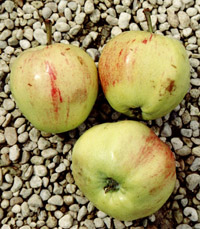 |
COMPTON WYNYATES An old tree brought to our notice by Jane Jervis of Home Farm, Compton Wynyates, Sibford, Warwickshire and renamed by us since the original variety name is lost. Home Farm was built in the 1870s as the Bailiff’s House for the famous Tudor mansion of Compton Wynyates. The drive was shared when Mr and Mrs Jervis came 50 years ago and an old orchard along the drive once formed part of the larger estate. The tree looked to be well over 100 years old. The small to medium sized apple is an early eater, heavily ribbed, oval/conic, pale green and whitish, with red stripes over a third of the skin. It is pleasantly sweet and well flavoured, but does not keep for more than a few weeks and is best straight from the tree. Ripe early September. Pollination Group 3 | |||
|
||||